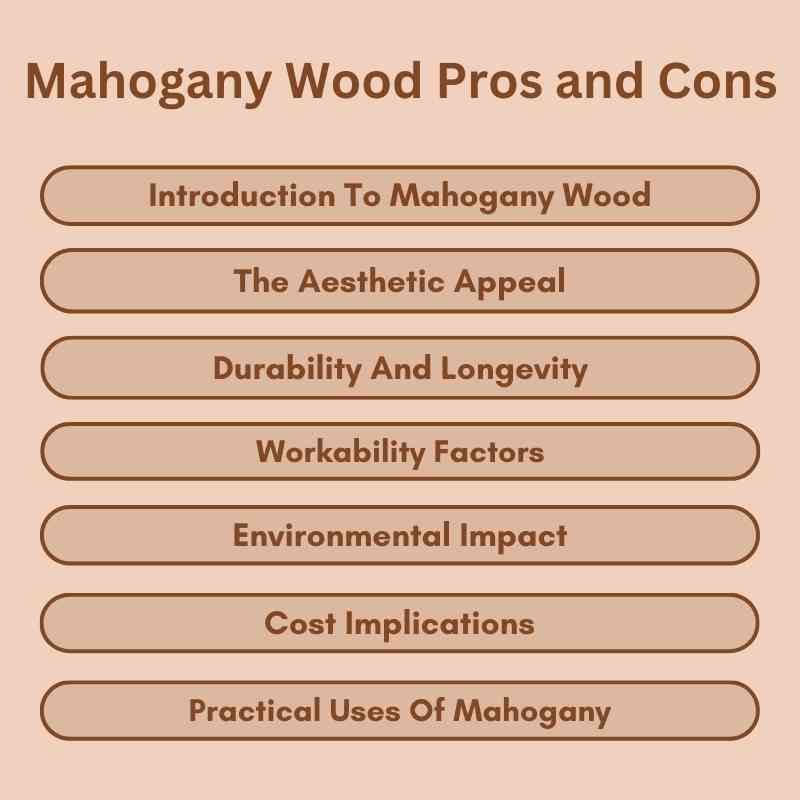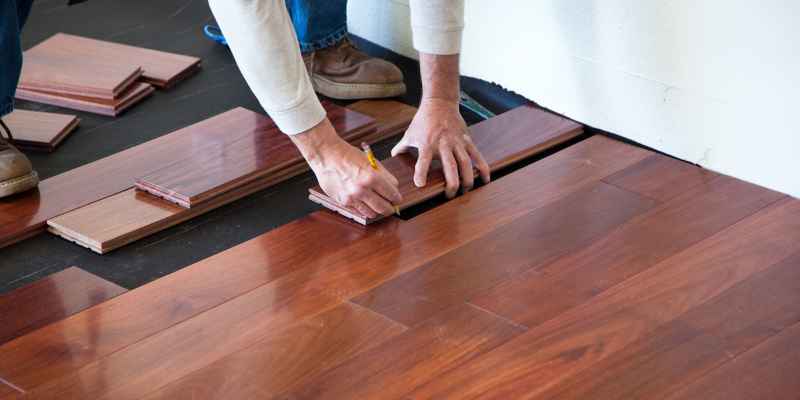Mahogany Wood Pros and Cons: Mahogany wood offers durability and a rich aesthetic appeal but can be expensive and susceptible to environmental changes. Its maintenance requires regular care to preserve its beauty.
Mahogany wood has long been prized for its stunning appearance and resilience. This hardwood originates from tropical regions, making it a popular choice for furniture, cabinetry, and flooring. Its warm tones and fine grain enhance any space, adding a touch of elegance.
While mahogany is celebrated for its durability, it also poses challenges such as a higher cost and sensitivity to humidity. Understanding the pros and cons helps homeowners and builders make informed choices. Whether you’re considering mahogany for a new project or simply exploring options, knowing its strengths and weaknesses is essential for achieving the best results.
Introduction To Mahogany Wood
Mahogany wood is a popular choice for furniture and decor. Its rich color and durability make it stand out. Many love its warm, reddish-brown hue. This wood has a long history and many uses.
The Allure Of Mahogany
Mahogany has several appealing features:
- Beautiful Appearance: Its color varies from light to dark.
- Durability: It withstands wear and tear well.
- Workability: Easy to carve and shape.
- Resistance: Naturally resists pests and decay.
People often choose mahogany for high-quality furniture. Its beauty enhances any space. Mahogany is also used for musical instruments and boats. Its versatility makes it a favorite among artisans.
Historical Significance
Mahogany wood has a rich history. It was prized by shipbuilders in the 18th century. The wood came from the Americas, mainly the Caribbean. It became popular in Europe, especially in England.
Colonial furniture makers loved mahogany. They crafted elegant pieces that remain sought after. Mahogany symbolizes luxury and craftsmanship.
Today, mahogany is still valued. It represents tradition and quality in woodworking. Collectors seek antique mahogany items. Its historical significance continues to attract attention.

The Aesthetic Appeal
Mahogany wood is renowned for its stunning beauty. Its rich colors and unique grain patterns make it a favorite in furniture design. Let’s explore the key aspects that contribute to its aesthetic charm.
Color And Grain Patterns
Mahogany wood boasts a warm, reddish-brown hue. This color deepens with age, enhancing its elegance. The grain patterns add to its visual interest.
- Straight grain is common.
- Some pieces feature wavy or interlocking patterns.
- Color variations occur from light to dark shades.
This variety makes each piece unique. Mahogany stands out in any room.
Finishing And Craftsmanship
Finishing mahogany enhances its natural beauty. The wood accepts stains and varnishes well. This allows for a glossy, rich appearance.
| Finishing Type | Effect on Aesthetics |
|---|---|
| Natural Oil | Brings out warmth and depth. |
| Clear Varnish | Adds a shiny, protective layer. |
| Stain | Enhances color richness. |
High-quality craftsmanship showcases mahogany’s beauty. Skilled artisans highlight its natural features. This makes mahogany furniture a timeless choice.
Durability And Longevity
Mahogany wood is known for its impressive durability. This wood is strong and resistant. It lasts a long time, making it a popular choice for furniture and construction.
Resistance To Decay
Mahogany has natural properties that make it resistant to decay. This wood fights off moisture and pests effectively. Here are some key points:
- Water Resistance: Mahogany repels water, reducing mold growth.
- Pest Resistance: Insects find it hard to attack mahogany.
- Fungal Resistance: It resists fungus, which can cause decay.
This resistance helps mahogany maintain its beauty over time. It can withstand harsh environments, making it ideal for outdoor furniture.
Lifespan In Furniture And Construction
Mahogany wood has an impressive lifespan. It can last for decades, even generations. Here’s a breakdown of its lifespan:
| Application | Estimated Lifespan |
|---|---|
| Indoor Furniture | 50-100 years |
| Outdoor Furniture | 25-50 years |
| Construction (e.g., flooring) | 75-100 years |
Investing in mahogany is wise. Its long-lasting nature saves money over time. Less frequent replacements mean fewer resources used.
Workability Factors
Understanding the workability of mahogany wood helps in making informed choices. This wood is popular among carpenters and woodworkers. Let’s explore its ease of use in cutting, shaping, and finishing.
Ease Of Cutting And Shaping
Mahogany wood is known for its excellent workability. It cuts smoothly with minimal effort. Here are some key points:
- Softness: Mahogany is relatively soft compared to other hardwoods.
- Tools: Standard tools work well with mahogany.
- Dust: It produces fine dust while cutting, which is easy to manage.
This wood holds edges well. It allows for intricate designs and shapes. Its uniform grain makes it predictable when shaping. This helps in avoiding unwanted splits.
Gluing And Finishing Considerations
Gluing and finishing mahogany wood require specific care. Here are some important factors:
| Consideration | Details |
|---|---|
| Adhesive Type | Use PVA glue for best results. |
| Surface Preparation | Sand surfaces well for better adhesion. |
| Finish Type | Oil-based finishes enhance the wood’s natural beauty. |
Mahogany wood accepts stains and finishes evenly. This enhances its rich color. Use caution with water-based finishes; they may raise the grain. Always test on a scrap piece first.
Proper gluing and finishing ensure a long-lasting, beautiful project. Enjoy working with this versatile wood!
Environmental Impact
Mahogany wood is popular for its beauty and durability. Its environmental impact raises important questions. Understanding the effects helps consumers make informed choices.
Sustainability Concerns
Sustainability is a major issue with mahogany wood. Overharvesting has led to significant deforestation. This threatens wildlife and natural habitats.
Some mahogany species take decades to mature. Rapid logging reduces forest cover. This can cause soil erosion and climate change.
Key sustainability issues include:
- Deforestation
- Loss of biodiversity
- Soil erosion
- Climate change
Certification And Ethical Sourcing
Ethical sourcing is essential for mahogany wood. Certifications ensure responsible harvesting practices. Look for these certifications:
| Certification | Description |
|---|---|
| FSC (Forest Stewardship Council) | Ensures responsible forest management. |
| PEFC (Programme for the Endorsement of Forest Certification) | Promotes sustainable forest practices. |
Choosing certified wood helps protect forests. It supports local communities and wildlife. Consumers play a vital role in promoting sustainability.
Cost Implications
Understanding the cost implications of Mahogany wood is essential. This beautiful hardwood comes with both advantages and disadvantages. Let’s explore the financial aspects in detail.
Comparative Market Prices
Mahogany wood is often priced higher than other types of wood. Here is a breakdown of typical market prices:
| Wood Type | Price per Board Foot |
|---|---|
| Mahogany | $8 – $15 |
| Oak | $3 – $7 |
| Pine | $2 – $5 |
These prices vary based on quality and source. Mahogany is known for its rich color and durability, justifying its higher cost.
Long-term Value
Investing in Mahogany wood offers long-term benefits. Here are some key points:
- Durability: Mahogany lasts for decades without significant wear.
- Resale Value: Furniture made of Mahogany retains value over time.
- Low Maintenance: Requires minimal upkeep, saving money in the long run.
Choose Mahogany for its quality and longevity. It may cost more upfront, but savings come from its lasting nature.
Practical Uses Of Mahogany
Mahogany wood is highly sought after for its beauty and durability. Its rich color and fine grain make it a favorite in many applications. This section explores two main uses: furniture making and architectural applications.
In Furniture Making
Mahogany is a top choice for furniture makers. Its strength and stunning appearance create lasting pieces. Here are some key benefits:
- Durability: Mahogany withstands wear and tear.
- Workability: It is easy to carve and shape.
- Finish: Mahogany takes stains and finishes well.
- Timeless Appeal: Its classic look never goes out of style.
Common furniture items made from mahogany include:
- Dining tables
- Chairs
- Cabinets
- Desks
Architectural Applications
Mahogany plays a significant role in architecture. Its strength and resistance to decay make it suitable for various structures. Here are some common uses:
- Doors: Mahogany doors offer security and beauty.
- Windows: It provides excellent insulation.
- Trim and Moldings: Adds elegance to interior spaces.
- Decking: Ideal for outdoor projects due to its durability.
In summary, mahogany wood is versatile and attractive. Its practical uses in furniture and architecture make it a valuable material.

Limitations And Drawbacks
Mahogany wood is famous for its beauty and durability. Yet, it has some limitations. Understanding these drawbacks is essential before choosing it for projects.
Susceptibility To Certain Damages
Mahogany wood, while strong, has some vulnerabilities:
- Scratches: Its surface can get scratched easily.
- Water Damage: Prolonged exposure to moisture can cause warping.
- Insect Infestation: Termites and beetles can damage untreated wood.
- Sunlight Fading: Direct sunlight can fade its rich color.
Availability And Legal Restrictions
Finding mahogany wood can be challenging due to several factors:
| Factor | Details |
|---|---|
| Scarcity | Some species are endangered, making them rare. |
| Legal Restrictions | Trade laws can limit availability in some regions. |
| Cost | High demand often leads to increased prices. |
These factors can affect your project budget and timelines.
Maintenance And Care
Maintaining and caring for mahogany wood ensures its beauty lasts. Proper care enhances its durability and keeps it looking stunning.
Cleaning Tips
Regular cleaning keeps your mahogany wood furniture in top shape. Here are some effective cleaning tips:
- Dust regularly: Use a soft, dry cloth.
- Avoid water: Excess water can damage the wood.
- Use mild cleaners: Choose pH-balanced wood cleaners.
- Wipe spills immediately: Prevent stains from setting.
For deeper cleaning, follow these steps:
- Mix mild soap with warm water.
- Dampen a cloth with the solution.
- Gently wipe the surface.
- Dry with a clean, soft cloth.
Repair And Restoration Techniques
Over time, mahogany wood may show wear. Here are some repair and restoration techniques:
| Issue | Technique |
|---|---|
| Scratches | Use a wood filler or wax crayon. |
| Dents | Apply steam to raise the dent. |
| Fading | Re-oil with a suitable wood oil. |
| Loose joints | Use wood glue to re-secure. |
Regular maintenance and timely repairs keep mahogany wood looking great.
Conclusion: Balancing Pros And Cons
Choosing mahogany wood involves understanding both its advantages and disadvantages. This beautiful wood type brings unique qualities, but it also has its downsides. Weighing these factors helps in making the best decision for your project.
Making An Informed Choice
Consider the following points before making a decision:
| Pros | Cons |
|---|---|
| Rich color and grain | High cost |
| Durable and strong | Susceptible to scratches |
| Resistant to rot | Environmental concerns |
| Easy to work with | Limited availability |
Weigh these factors carefully. Think about your specific needs and budget. Mahogany’s beauty adds elegance. Its durability ensures longevity. But, the cost can be a hurdle.
The Timeless Charm Of Mahogany
Mahogany has a rich history. It is often associated with luxury and craftsmanship. Its warm tones and fine grain make it a favorite for furniture and cabinetry. Many people love its aesthetic appeal.
- Creates stunning furniture pieces
- Perfect for intricate carvings
- Enhances any interior design
Remember, mahogany wood can be a great investment. It stands the test of time. Choose wisely based on your requirements.
Frequently Asked Questions
What Are The Benefits Of Mahogany Wood?
Mahogany wood is known for its durability and resistance to decay. It has a beautiful, rich color that enhances any furniture or decor. Additionally, mahogany is easy to work with, making it ideal for intricate carvings and designs. Its stability helps prevent warping and splitting over time.
Is Mahogany Wood Expensive?
Yes, mahogany wood is generally considered expensive. Its high price is due to its quality, rarity, and demand. Sustainable sourcing can also affect costs. However, investing in mahogany can be worthwhile for its longevity and aesthetic appeal. It often outlasts cheaper alternatives, providing long-term value.
How To Care For Mahogany Furniture?
Caring for mahogany furniture involves regular dusting and occasional polishing. Use a soft, lint-free cloth to clean surfaces. Avoid harsh chemicals that can damage the finish. To maintain its luster, apply a high-quality wood polish every few months. Keeping it away from direct sunlight will also prevent fading.
Is Mahogany Wood Eco-friendly?
Mahogany wood can be eco-friendly if sourced sustainably. Look for certifications like FSC (Forest Stewardship Council) to ensure responsible harvesting practices. Sustainable mahogany supports reforestation and conservation efforts. However, some mahogany species are endangered, so it’s vital to research the source before purchasing.
Conclusion
Choosing mahogany wood involves weighing its benefits and drawbacks. Its durability and beauty make it a popular choice for furniture and decor. Yet, the cost and environmental concerns can be significant factors. Understanding these pros and cons will help you make an informed decision that suits your needs.

